Servant leadership versus Authentic leadership
VerifiedAdded on 2022/09/18
|11
|2654
|48
AI Summary
Contribute Materials
Your contribution can guide someone’s learning journey. Share your
documents today.
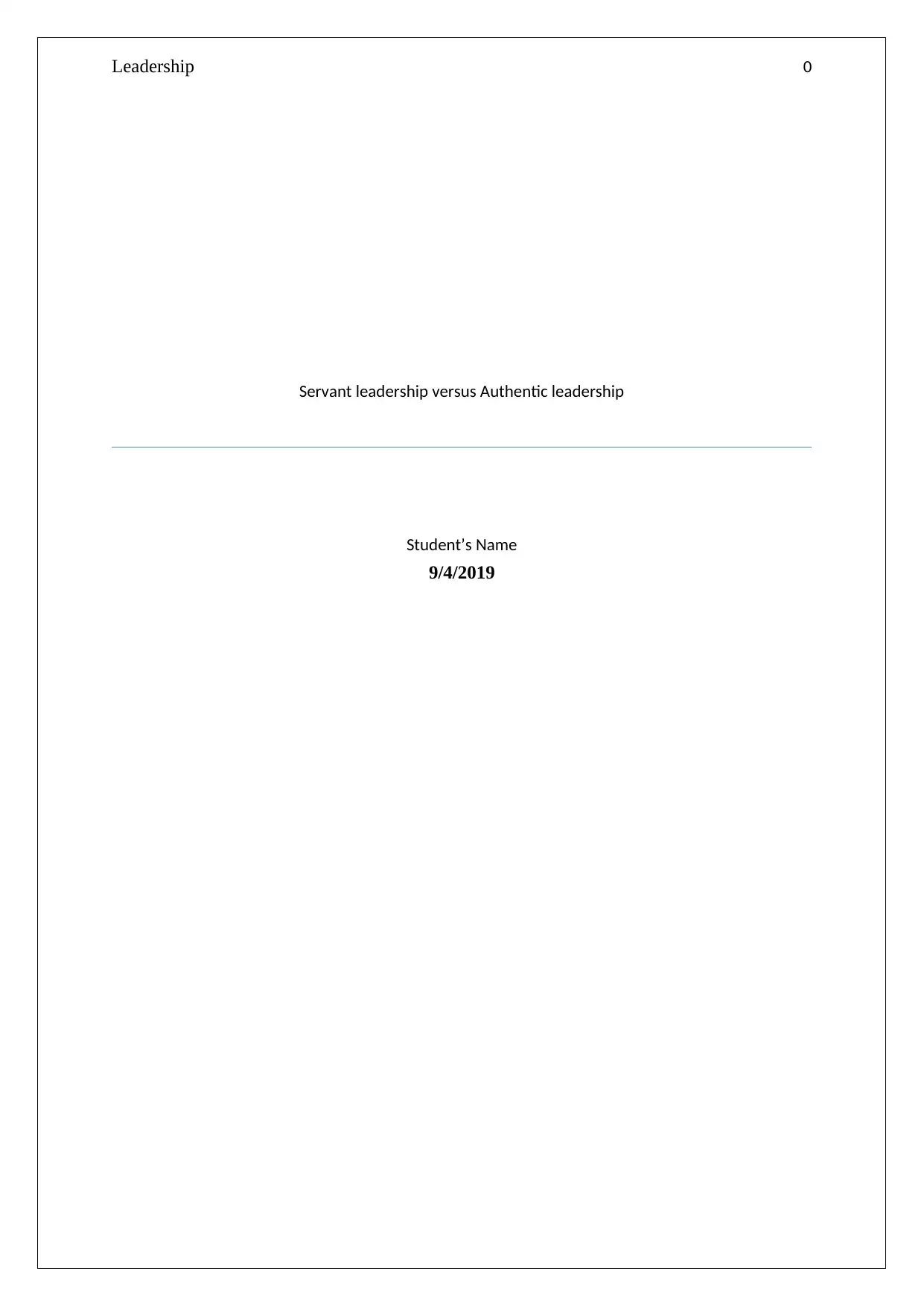
Leadership 0
Servant leadership versus Authentic leadership
Student’s Name
9/4/2019
Servant leadership versus Authentic leadership
Student’s Name
9/4/2019
Secure Best Marks with AI Grader
Need help grading? Try our AI Grader for instant feedback on your assignments.
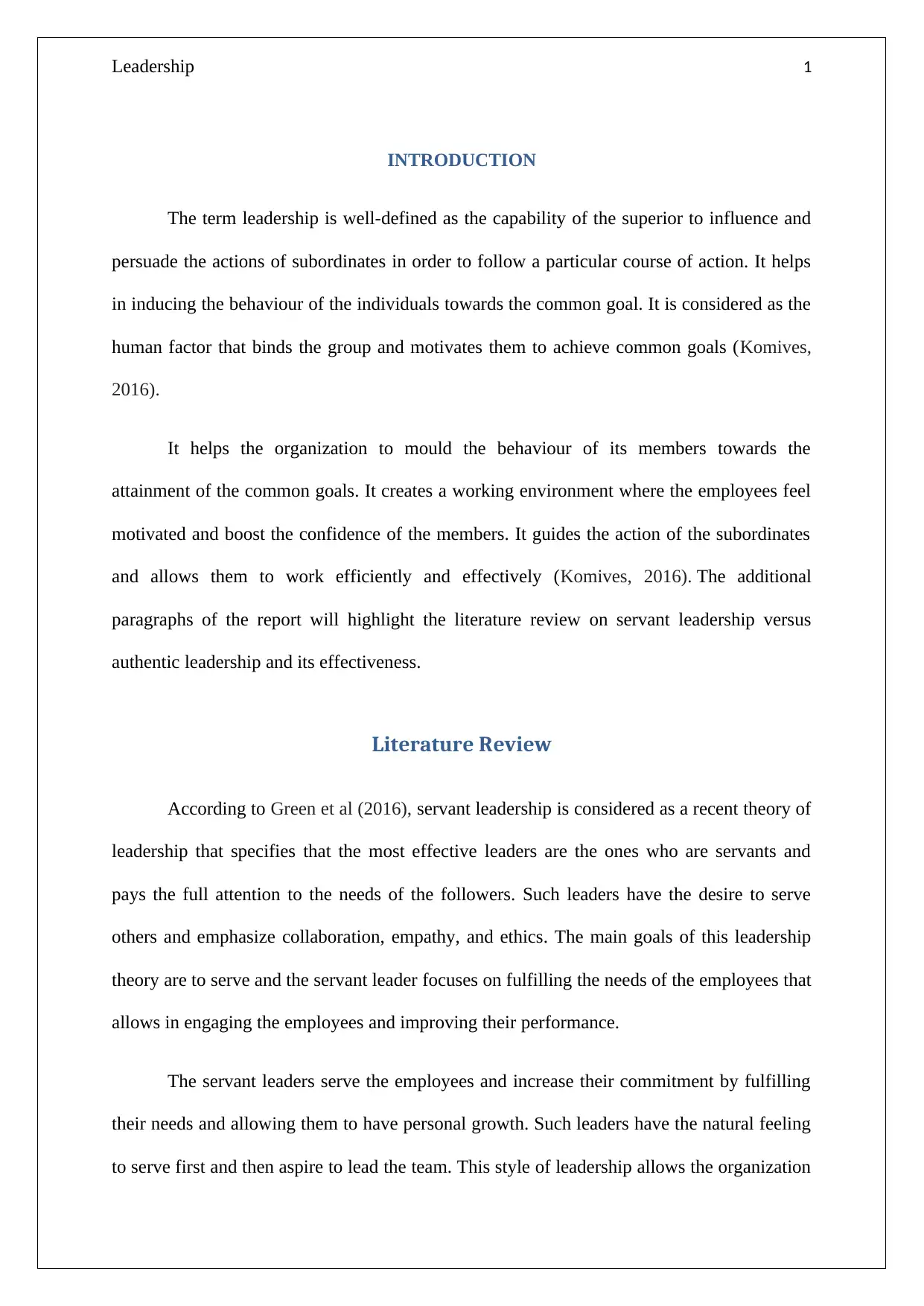
Leadership 1
INTRODUCTION
The term leadership is well-defined as the capability of the superior to influence and
persuade the actions of subordinates in order to follow a particular course of action. It helps
in inducing the behaviour of the individuals towards the common goal. It is considered as the
human factor that binds the group and motivates them to achieve common goals (Komives,
2016).
It helps the organization to mould the behaviour of its members towards the
attainment of the common goals. It creates a working environment where the employees feel
motivated and boost the confidence of the members. It guides the action of the subordinates
and allows them to work efficiently and effectively (Komives, 2016). The additional
paragraphs of the report will highlight the literature review on servant leadership versus
authentic leadership and its effectiveness.
Literature Review
According to Green et al (2016), servant leadership is considered as a recent theory of
leadership that specifies that the most effective leaders are the ones who are servants and
pays the full attention to the needs of the followers. Such leaders have the desire to serve
others and emphasize collaboration, empathy, and ethics. The main goals of this leadership
theory are to serve and the servant leader focuses on fulfilling the needs of the employees that
allows in engaging the employees and improving their performance.
The servant leaders serve the employees and increase their commitment by fulfilling
their needs and allowing them to have personal growth. Such leaders have the natural feeling
to serve first and then aspire to lead the team. This style of leadership allows the organization
INTRODUCTION
The term leadership is well-defined as the capability of the superior to influence and
persuade the actions of subordinates in order to follow a particular course of action. It helps
in inducing the behaviour of the individuals towards the common goal. It is considered as the
human factor that binds the group and motivates them to achieve common goals (Komives,
2016).
It helps the organization to mould the behaviour of its members towards the
attainment of the common goals. It creates a working environment where the employees feel
motivated and boost the confidence of the members. It guides the action of the subordinates
and allows them to work efficiently and effectively (Komives, 2016). The additional
paragraphs of the report will highlight the literature review on servant leadership versus
authentic leadership and its effectiveness.
Literature Review
According to Green et al (2016), servant leadership is considered as a recent theory of
leadership that specifies that the most effective leaders are the ones who are servants and
pays the full attention to the needs of the followers. Such leaders have the desire to serve
others and emphasize collaboration, empathy, and ethics. The main goals of this leadership
theory are to serve and the servant leader focuses on fulfilling the needs of the employees that
allows in engaging the employees and improving their performance.
The servant leaders serve the employees and increase their commitment by fulfilling
their needs and allowing them to have personal growth. Such leaders have the natural feeling
to serve first and then aspire to lead the team. This style of leadership allows the organization
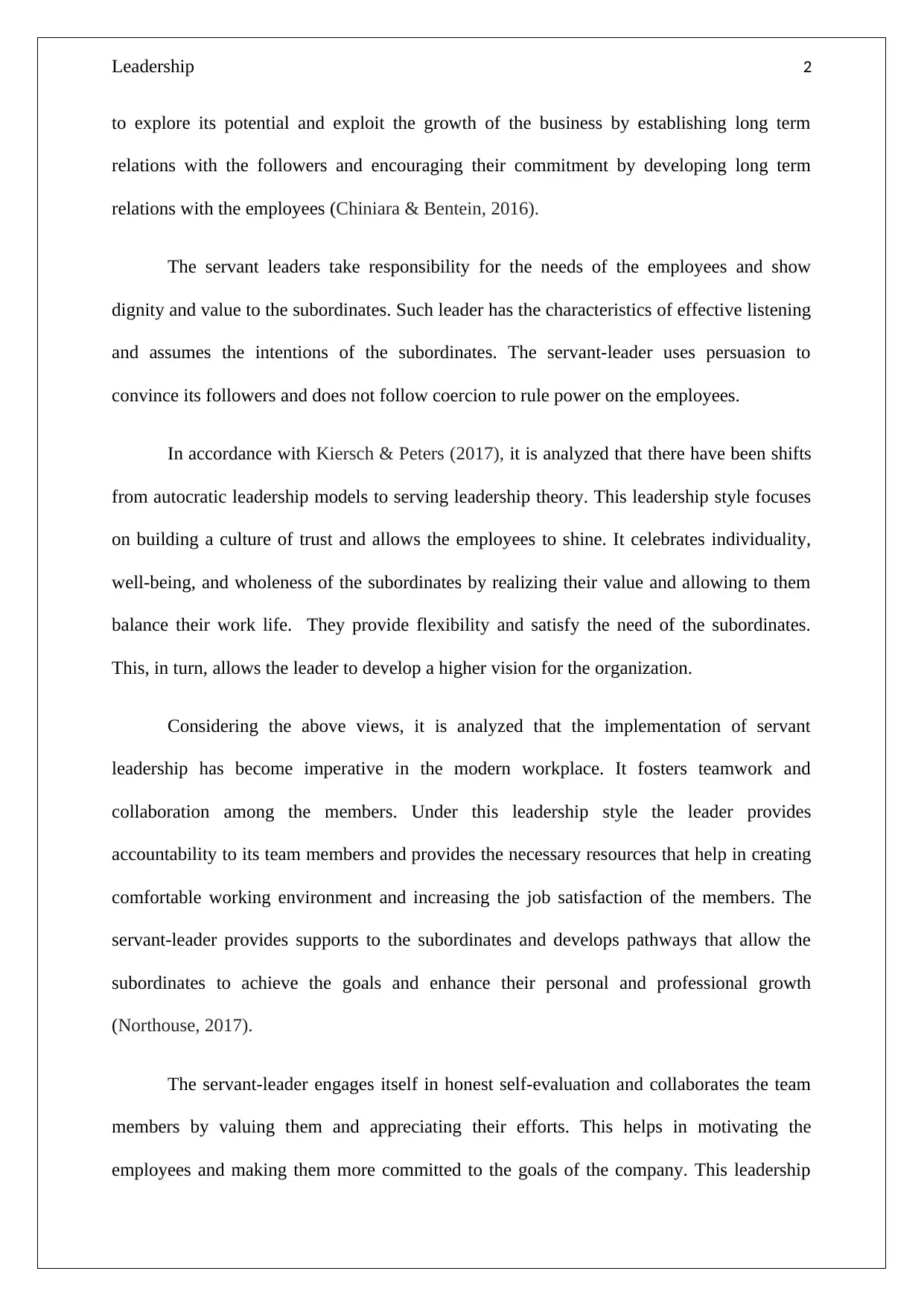
Leadership 2
to explore its potential and exploit the growth of the business by establishing long term
relations with the followers and encouraging their commitment by developing long term
relations with the employees (Chiniara & Bentein, 2016).
The servant leaders take responsibility for the needs of the employees and show
dignity and value to the subordinates. Such leader has the characteristics of effective listening
and assumes the intentions of the subordinates. The servant-leader uses persuasion to
convince its followers and does not follow coercion to rule power on the employees.
In accordance with Kiersch & Peters (2017), it is analyzed that there have been shifts
from autocratic leadership models to serving leadership theory. This leadership style focuses
on building a culture of trust and allows the employees to shine. It celebrates individuality,
well-being, and wholeness of the subordinates by realizing their value and allowing to them
balance their work life. They provide flexibility and satisfy the need of the subordinates.
This, in turn, allows the leader to develop a higher vision for the organization.
Considering the above views, it is analyzed that the implementation of servant
leadership has become imperative in the modern workplace. It fosters teamwork and
collaboration among the members. Under this leadership style the leader provides
accountability to its team members and provides the necessary resources that help in creating
comfortable working environment and increasing the job satisfaction of the members. The
servant-leader provides supports to the subordinates and develops pathways that allow the
subordinates to achieve the goals and enhance their personal and professional growth
(Northouse, 2017).
The servant-leader engages itself in honest self-evaluation and collaborates the team
members by valuing them and appreciating their efforts. This helps in motivating the
employees and making them more committed to the goals of the company. This leadership
to explore its potential and exploit the growth of the business by establishing long term
relations with the followers and encouraging their commitment by developing long term
relations with the employees (Chiniara & Bentein, 2016).
The servant leaders take responsibility for the needs of the employees and show
dignity and value to the subordinates. Such leader has the characteristics of effective listening
and assumes the intentions of the subordinates. The servant-leader uses persuasion to
convince its followers and does not follow coercion to rule power on the employees.
In accordance with Kiersch & Peters (2017), it is analyzed that there have been shifts
from autocratic leadership models to serving leadership theory. This leadership style focuses
on building a culture of trust and allows the employees to shine. It celebrates individuality,
well-being, and wholeness of the subordinates by realizing their value and allowing to them
balance their work life. They provide flexibility and satisfy the need of the subordinates.
This, in turn, allows the leader to develop a higher vision for the organization.
Considering the above views, it is analyzed that the implementation of servant
leadership has become imperative in the modern workplace. It fosters teamwork and
collaboration among the members. Under this leadership style the leader provides
accountability to its team members and provides the necessary resources that help in creating
comfortable working environment and increasing the job satisfaction of the members. The
servant-leader provides supports to the subordinates and develops pathways that allow the
subordinates to achieve the goals and enhance their personal and professional growth
(Northouse, 2017).
The servant-leader engages itself in honest self-evaluation and collaborates the team
members by valuing them and appreciating their efforts. This helps in motivating the
employees and making them more committed to the goals of the company. This leadership
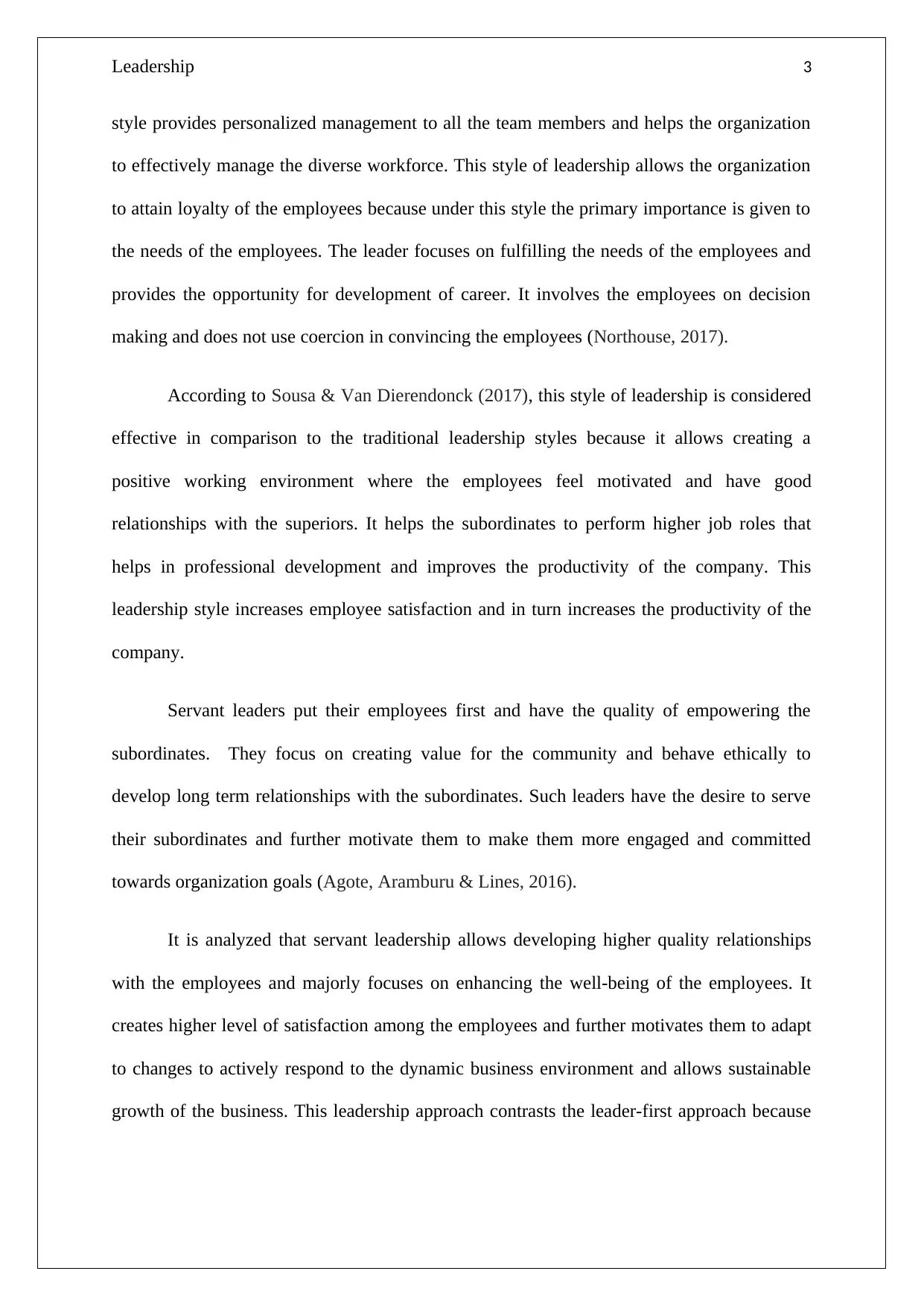
Leadership 3
style provides personalized management to all the team members and helps the organization
to effectively manage the diverse workforce. This style of leadership allows the organization
to attain loyalty of the employees because under this style the primary importance is given to
the needs of the employees. The leader focuses on fulfilling the needs of the employees and
provides the opportunity for development of career. It involves the employees on decision
making and does not use coercion in convincing the employees (Northouse, 2017).
According to Sousa & Van Dierendonck (2017), this style of leadership is considered
effective in comparison to the traditional leadership styles because it allows creating a
positive working environment where the employees feel motivated and have good
relationships with the superiors. It helps the subordinates to perform higher job roles that
helps in professional development and improves the productivity of the company. This
leadership style increases employee satisfaction and in turn increases the productivity of the
company.
Servant leaders put their employees first and have the quality of empowering the
subordinates. They focus on creating value for the community and behave ethically to
develop long term relationships with the subordinates. Such leaders have the desire to serve
their subordinates and further motivate them to make them more engaged and committed
towards organization goals (Agote, Aramburu & Lines, 2016).
It is analyzed that servant leadership allows developing higher quality relationships
with the employees and majorly focuses on enhancing the well-being of the employees. It
creates higher level of satisfaction among the employees and further motivates them to adapt
to changes to actively respond to the dynamic business environment and allows sustainable
growth of the business. This leadership approach contrasts the leader-first approach because
style provides personalized management to all the team members and helps the organization
to effectively manage the diverse workforce. This style of leadership allows the organization
to attain loyalty of the employees because under this style the primary importance is given to
the needs of the employees. The leader focuses on fulfilling the needs of the employees and
provides the opportunity for development of career. It involves the employees on decision
making and does not use coercion in convincing the employees (Northouse, 2017).
According to Sousa & Van Dierendonck (2017), this style of leadership is considered
effective in comparison to the traditional leadership styles because it allows creating a
positive working environment where the employees feel motivated and have good
relationships with the superiors. It helps the subordinates to perform higher job roles that
helps in professional development and improves the productivity of the company. This
leadership style increases employee satisfaction and in turn increases the productivity of the
company.
Servant leaders put their employees first and have the quality of empowering the
subordinates. They focus on creating value for the community and behave ethically to
develop long term relationships with the subordinates. Such leaders have the desire to serve
their subordinates and further motivate them to make them more engaged and committed
towards organization goals (Agote, Aramburu & Lines, 2016).
It is analyzed that servant leadership allows developing higher quality relationships
with the employees and majorly focuses on enhancing the well-being of the employees. It
creates higher level of satisfaction among the employees and further motivates them to adapt
to changes to actively respond to the dynamic business environment and allows sustainable
growth of the business. This leadership approach contrasts the leader-first approach because
Secure Best Marks with AI Grader
Need help grading? Try our AI Grader for instant feedback on your assignments.
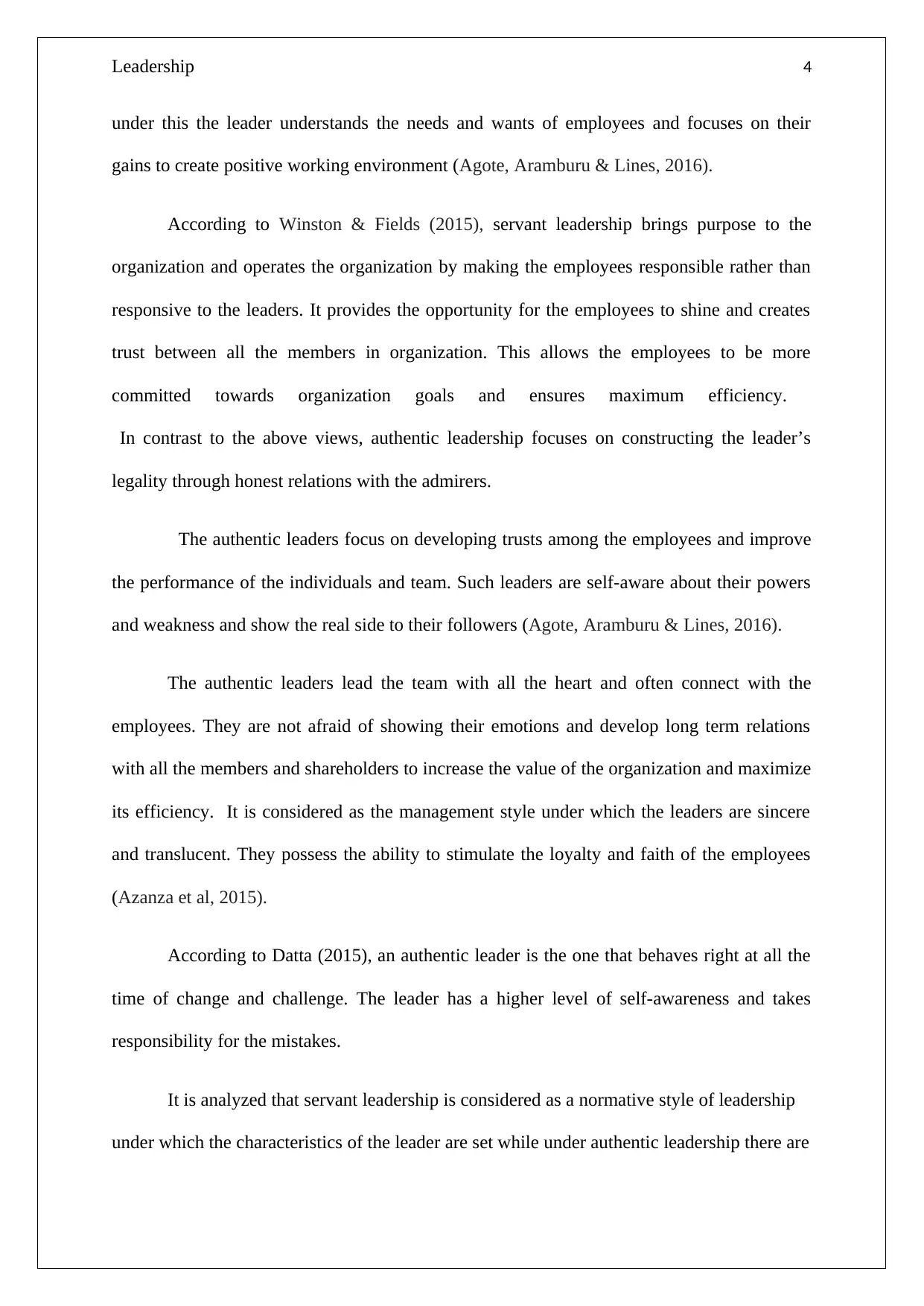
Leadership 4
under this the leader understands the needs and wants of employees and focuses on their
gains to create positive working environment (Agote, Aramburu & Lines, 2016).
According to Winston & Fields (2015), servant leadership brings purpose to the
organization and operates the organization by making the employees responsible rather than
responsive to the leaders. It provides the opportunity for the employees to shine and creates
trust between all the members in organization. This allows the employees to be more
committed towards organization goals and ensures maximum efficiency.
In contrast to the above views, authentic leadership focuses on constructing the leader’s
legality through honest relations with the admirers.
The authentic leaders focus on developing trusts among the employees and improve
the performance of the individuals and team. Such leaders are self-aware about their powers
and weakness and show the real side to their followers (Agote, Aramburu & Lines, 2016).
The authentic leaders lead the team with all the heart and often connect with the
employees. They are not afraid of showing their emotions and develop long term relations
with all the members and shareholders to increase the value of the organization and maximize
its efficiency. It is considered as the management style under which the leaders are sincere
and translucent. They possess the ability to stimulate the loyalty and faith of the employees
(Azanza et al, 2015).
According to Datta (2015), an authentic leader is the one that behaves right at all the
time of change and challenge. The leader has a higher level of self-awareness and takes
responsibility for the mistakes.
It is analyzed that servant leadership is considered as a normative style of leadership
under which the characteristics of the leader are set while under authentic leadership there are
under this the leader understands the needs and wants of employees and focuses on their
gains to create positive working environment (Agote, Aramburu & Lines, 2016).
According to Winston & Fields (2015), servant leadership brings purpose to the
organization and operates the organization by making the employees responsible rather than
responsive to the leaders. It provides the opportunity for the employees to shine and creates
trust between all the members in organization. This allows the employees to be more
committed towards organization goals and ensures maximum efficiency.
In contrast to the above views, authentic leadership focuses on constructing the leader’s
legality through honest relations with the admirers.
The authentic leaders focus on developing trusts among the employees and improve
the performance of the individuals and team. Such leaders are self-aware about their powers
and weakness and show the real side to their followers (Agote, Aramburu & Lines, 2016).
The authentic leaders lead the team with all the heart and often connect with the
employees. They are not afraid of showing their emotions and develop long term relations
with all the members and shareholders to increase the value of the organization and maximize
its efficiency. It is considered as the management style under which the leaders are sincere
and translucent. They possess the ability to stimulate the loyalty and faith of the employees
(Azanza et al, 2015).
According to Datta (2015), an authentic leader is the one that behaves right at all the
time of change and challenge. The leader has a higher level of self-awareness and takes
responsibility for the mistakes.
It is analyzed that servant leadership is considered as a normative style of leadership
under which the characteristics of the leader are set while under authentic leadership there are
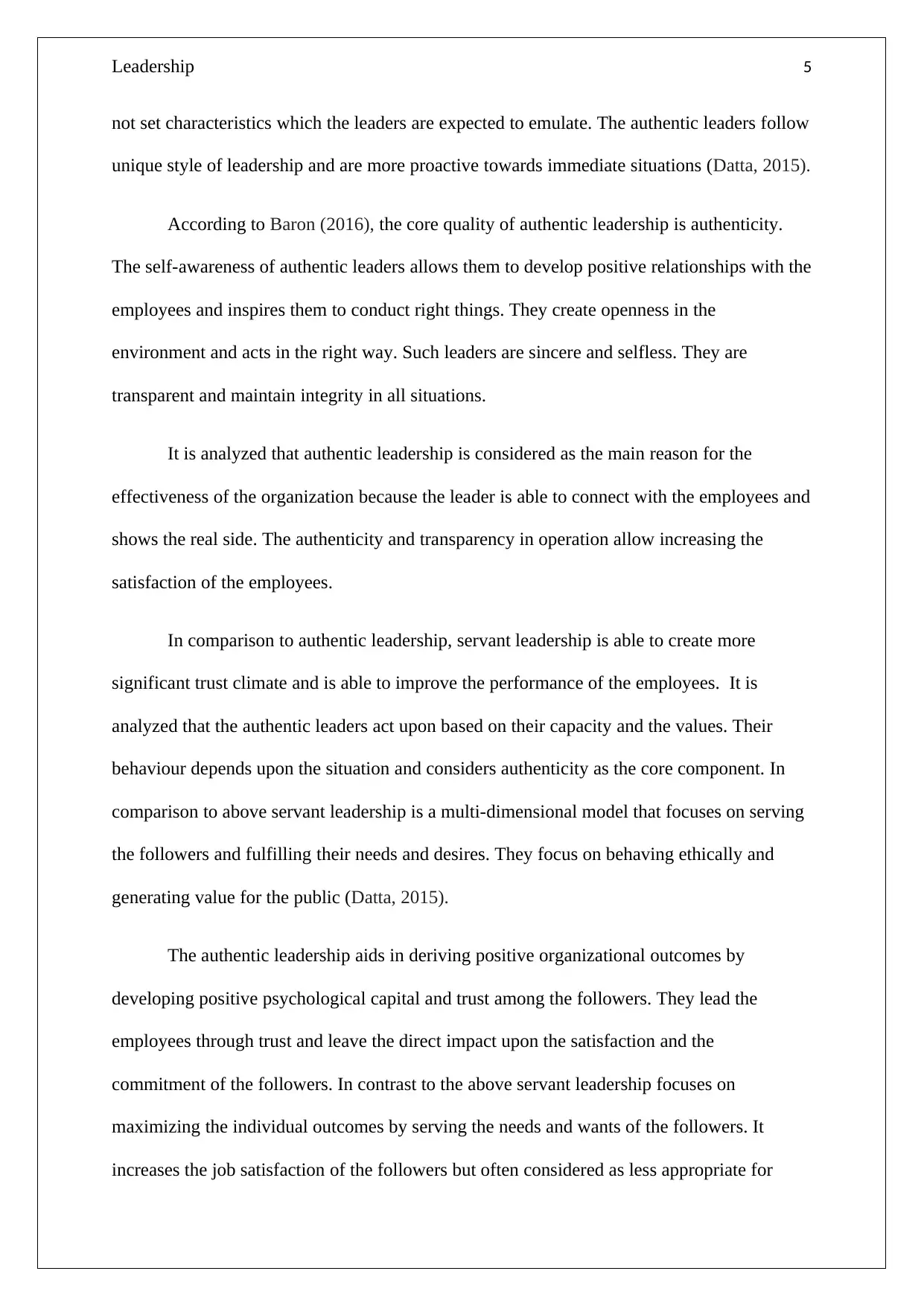
Leadership 5
not set characteristics which the leaders are expected to emulate. The authentic leaders follow
unique style of leadership and are more proactive towards immediate situations (Datta, 2015).
According to Baron (2016), the core quality of authentic leadership is authenticity.
The self-awareness of authentic leaders allows them to develop positive relationships with the
employees and inspires them to conduct right things. They create openness in the
environment and acts in the right way. Such leaders are sincere and selfless. They are
transparent and maintain integrity in all situations.
It is analyzed that authentic leadership is considered as the main reason for the
effectiveness of the organization because the leader is able to connect with the employees and
shows the real side. The authenticity and transparency in operation allow increasing the
satisfaction of the employees.
In comparison to authentic leadership, servant leadership is able to create more
significant trust climate and is able to improve the performance of the employees. It is
analyzed that the authentic leaders act upon based on their capacity and the values. Their
behaviour depends upon the situation and considers authenticity as the core component. In
comparison to above servant leadership is a multi-dimensional model that focuses on serving
the followers and fulfilling their needs and desires. They focus on behaving ethically and
generating value for the public (Datta, 2015).
The authentic leadership aids in deriving positive organizational outcomes by
developing positive psychological capital and trust among the followers. They lead the
employees through trust and leave the direct impact upon the satisfaction and the
commitment of the followers. In contrast to the above servant leadership focuses on
maximizing the individual outcomes by serving the needs and wants of the followers. It
increases the job satisfaction of the followers but often considered as less appropriate for
not set characteristics which the leaders are expected to emulate. The authentic leaders follow
unique style of leadership and are more proactive towards immediate situations (Datta, 2015).
According to Baron (2016), the core quality of authentic leadership is authenticity.
The self-awareness of authentic leaders allows them to develop positive relationships with the
employees and inspires them to conduct right things. They create openness in the
environment and acts in the right way. Such leaders are sincere and selfless. They are
transparent and maintain integrity in all situations.
It is analyzed that authentic leadership is considered as the main reason for the
effectiveness of the organization because the leader is able to connect with the employees and
shows the real side. The authenticity and transparency in operation allow increasing the
satisfaction of the employees.
In comparison to authentic leadership, servant leadership is able to create more
significant trust climate and is able to improve the performance of the employees. It is
analyzed that the authentic leaders act upon based on their capacity and the values. Their
behaviour depends upon the situation and considers authenticity as the core component. In
comparison to above servant leadership is a multi-dimensional model that focuses on serving
the followers and fulfilling their needs and desires. They focus on behaving ethically and
generating value for the public (Datta, 2015).
The authentic leadership aids in deriving positive organizational outcomes by
developing positive psychological capital and trust among the followers. They lead the
employees through trust and leave the direct impact upon the satisfaction and the
commitment of the followers. In contrast to the above servant leadership focuses on
maximizing the individual outcomes by serving the needs and wants of the followers. It
increases the job satisfaction of the followers but often considered as less appropriate for
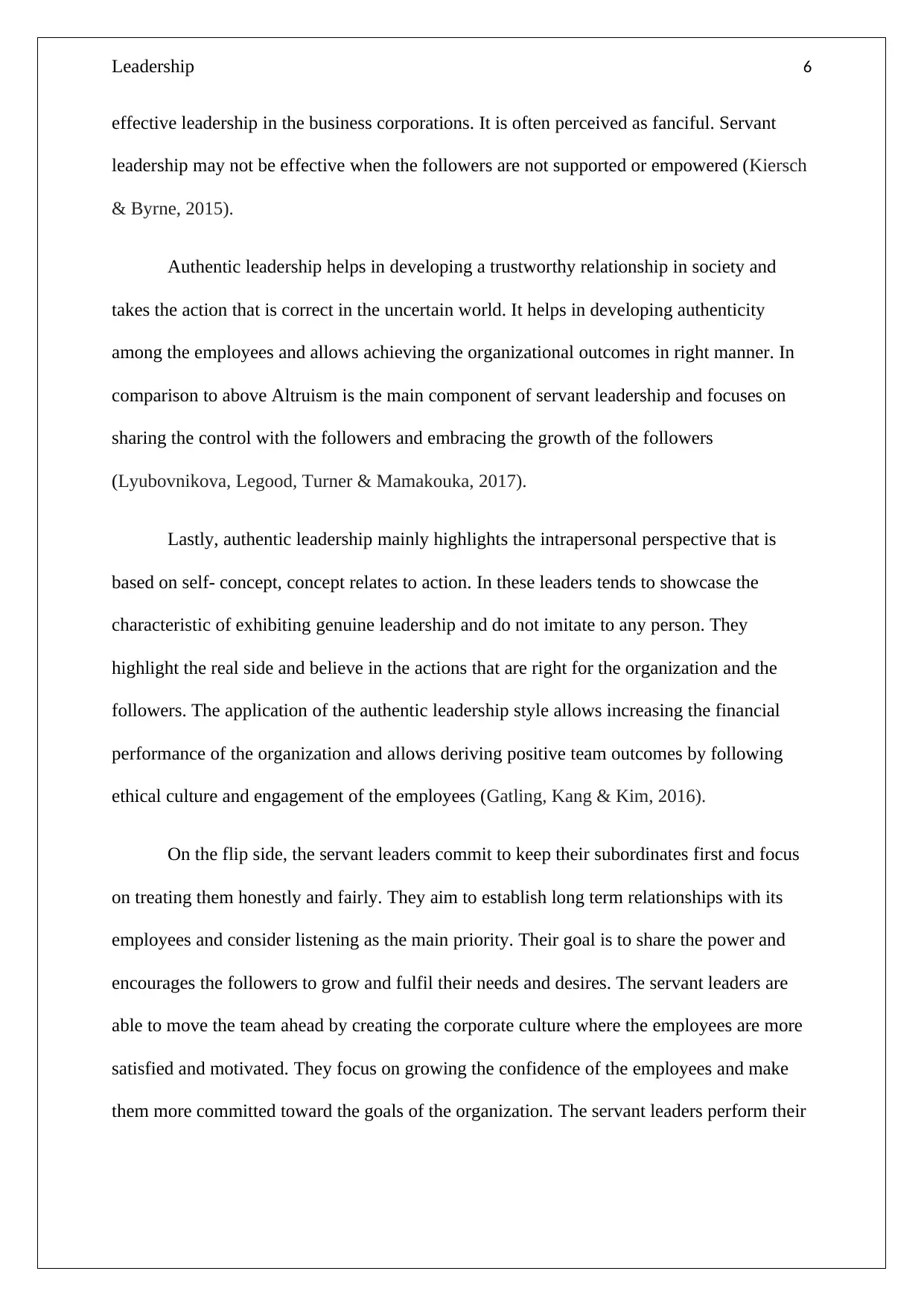
Leadership 6
effective leadership in the business corporations. It is often perceived as fanciful. Servant
leadership may not be effective when the followers are not supported or empowered (Kiersch
& Byrne, 2015).
Authentic leadership helps in developing a trustworthy relationship in society and
takes the action that is correct in the uncertain world. It helps in developing authenticity
among the employees and allows achieving the organizational outcomes in right manner. In
comparison to above Altruism is the main component of servant leadership and focuses on
sharing the control with the followers and embracing the growth of the followers
(Lyubovnikova, Legood, Turner & Mamakouka, 2017).
Lastly, authentic leadership mainly highlights the intrapersonal perspective that is
based on self- concept, concept relates to action. In these leaders tends to showcase the
characteristic of exhibiting genuine leadership and do not imitate to any person. They
highlight the real side and believe in the actions that are right for the organization and the
followers. The application of the authentic leadership style allows increasing the financial
performance of the organization and allows deriving positive team outcomes by following
ethical culture and engagement of the employees (Gatling, Kang & Kim, 2016).
On the flip side, the servant leaders commit to keep their subordinates first and focus
on treating them honestly and fairly. They aim to establish long term relationships with its
employees and consider listening as the main priority. Their goal is to share the power and
encourages the followers to grow and fulfil their needs and desires. The servant leaders are
able to move the team ahead by creating the corporate culture where the employees are more
satisfied and motivated. They focus on growing the confidence of the employees and make
them more committed toward the goals of the organization. The servant leaders perform their
effective leadership in the business corporations. It is often perceived as fanciful. Servant
leadership may not be effective when the followers are not supported or empowered (Kiersch
& Byrne, 2015).
Authentic leadership helps in developing a trustworthy relationship in society and
takes the action that is correct in the uncertain world. It helps in developing authenticity
among the employees and allows achieving the organizational outcomes in right manner. In
comparison to above Altruism is the main component of servant leadership and focuses on
sharing the control with the followers and embracing the growth of the followers
(Lyubovnikova, Legood, Turner & Mamakouka, 2017).
Lastly, authentic leadership mainly highlights the intrapersonal perspective that is
based on self- concept, concept relates to action. In these leaders tends to showcase the
characteristic of exhibiting genuine leadership and do not imitate to any person. They
highlight the real side and believe in the actions that are right for the organization and the
followers. The application of the authentic leadership style allows increasing the financial
performance of the organization and allows deriving positive team outcomes by following
ethical culture and engagement of the employees (Gatling, Kang & Kim, 2016).
On the flip side, the servant leaders commit to keep their subordinates first and focus
on treating them honestly and fairly. They aim to establish long term relationships with its
employees and consider listening as the main priority. Their goal is to share the power and
encourages the followers to grow and fulfil their needs and desires. The servant leaders are
able to move the team ahead by creating the corporate culture where the employees are more
satisfied and motivated. They focus on growing the confidence of the employees and make
them more committed toward the goals of the organization. The servant leaders perform their
Paraphrase This Document
Need a fresh take? Get an instant paraphrase of this document with our AI Paraphraser
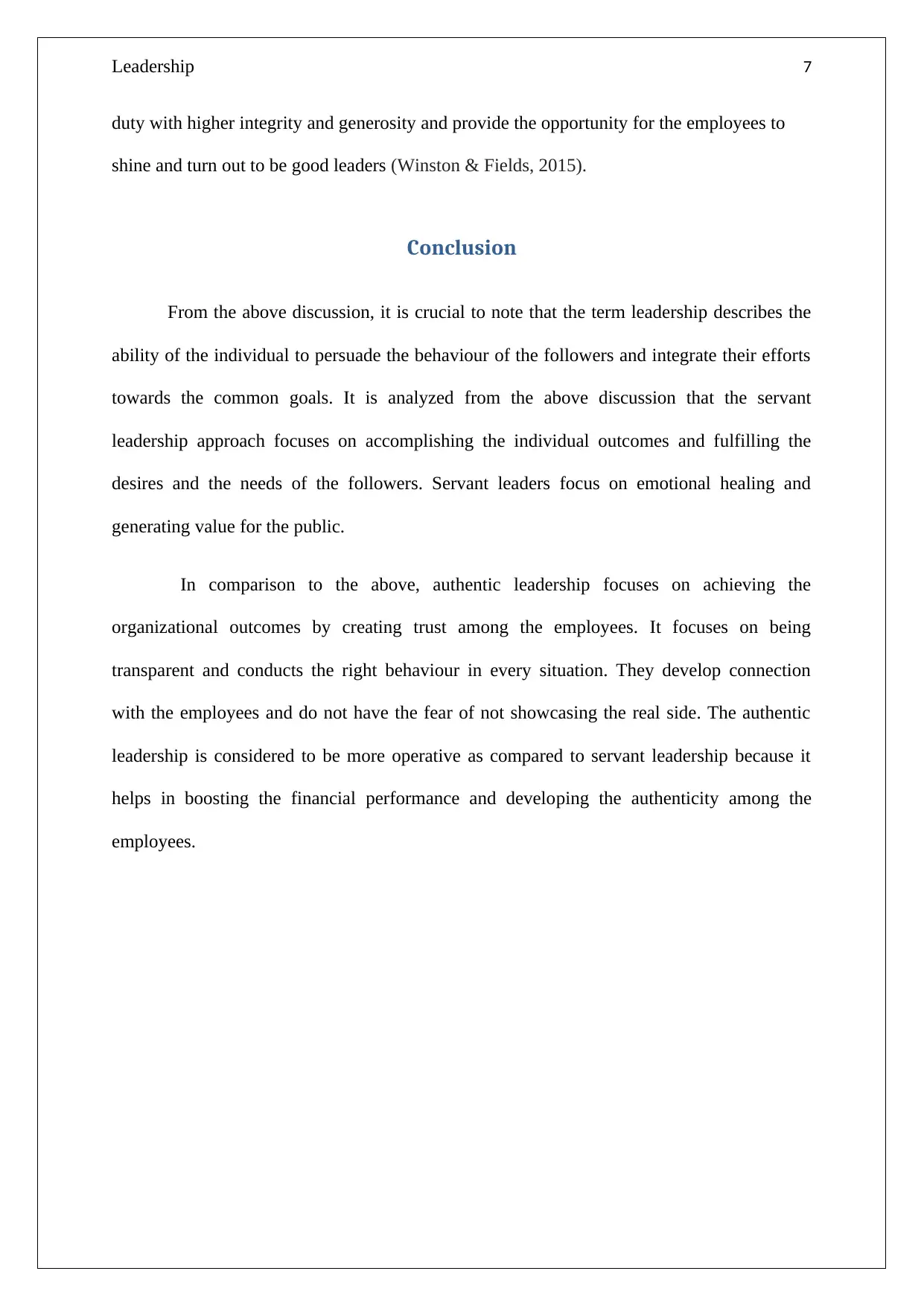
Leadership 7
duty with higher integrity and generosity and provide the opportunity for the employees to
shine and turn out to be good leaders (Winston & Fields, 2015).
Conclusion
From the above discussion, it is crucial to note that the term leadership describes the
ability of the individual to persuade the behaviour of the followers and integrate their efforts
towards the common goals. It is analyzed from the above discussion that the servant
leadership approach focuses on accomplishing the individual outcomes and fulfilling the
desires and the needs of the followers. Servant leaders focus on emotional healing and
generating value for the public.
In comparison to the above, authentic leadership focuses on achieving the
organizational outcomes by creating trust among the employees. It focuses on being
transparent and conducts the right behaviour in every situation. They develop connection
with the employees and do not have the fear of not showcasing the real side. The authentic
leadership is considered to be more operative as compared to servant leadership because it
helps in boosting the financial performance and developing the authenticity among the
employees.
duty with higher integrity and generosity and provide the opportunity for the employees to
shine and turn out to be good leaders (Winston & Fields, 2015).
Conclusion
From the above discussion, it is crucial to note that the term leadership describes the
ability of the individual to persuade the behaviour of the followers and integrate their efforts
towards the common goals. It is analyzed from the above discussion that the servant
leadership approach focuses on accomplishing the individual outcomes and fulfilling the
desires and the needs of the followers. Servant leaders focus on emotional healing and
generating value for the public.
In comparison to the above, authentic leadership focuses on achieving the
organizational outcomes by creating trust among the employees. It focuses on being
transparent and conducts the right behaviour in every situation. They develop connection
with the employees and do not have the fear of not showcasing the real side. The authentic
leadership is considered to be more operative as compared to servant leadership because it
helps in boosting the financial performance and developing the authenticity among the
employees.

Leadership 8
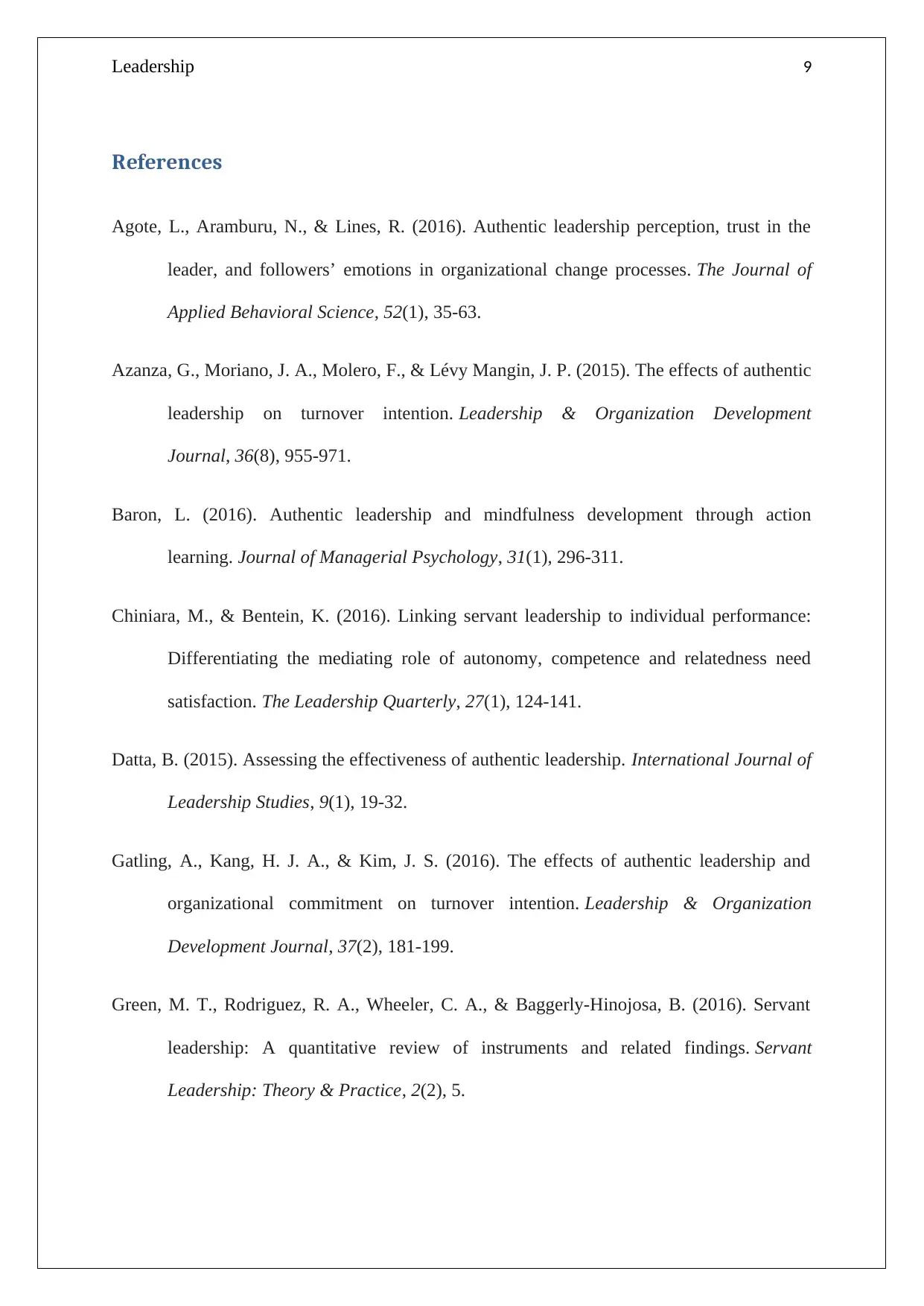
Leadership 9
References
Agote, L., Aramburu, N., & Lines, R. (2016). Authentic leadership perception, trust in the
leader, and followers’ emotions in organizational change processes. The Journal of
Applied Behavioral Science, 52(1), 35-63.
Azanza, G., Moriano, J. A., Molero, F., & Lévy Mangin, J. P. (2015). The effects of authentic
leadership on turnover intention. Leadership & Organization Development
Journal, 36(8), 955-971.
Baron, L. (2016). Authentic leadership and mindfulness development through action
learning. Journal of Managerial Psychology, 31(1), 296-311.
Chiniara, M., & Bentein, K. (2016). Linking servant leadership to individual performance:
Differentiating the mediating role of autonomy, competence and relatedness need
satisfaction. The Leadership Quarterly, 27(1), 124-141.
Datta, B. (2015). Assessing the effectiveness of authentic leadership. International Journal of
Leadership Studies, 9(1), 19-32.
Gatling, A., Kang, H. J. A., & Kim, J. S. (2016). The effects of authentic leadership and
organizational commitment on turnover intention. Leadership & Organization
Development Journal, 37(2), 181-199.
Green, M. T., Rodriguez, R. A., Wheeler, C. A., & Baggerly-Hinojosa, B. (2016). Servant
leadership: A quantitative review of instruments and related findings. Servant
Leadership: Theory & Practice, 2(2), 5.
References
Agote, L., Aramburu, N., & Lines, R. (2016). Authentic leadership perception, trust in the
leader, and followers’ emotions in organizational change processes. The Journal of
Applied Behavioral Science, 52(1), 35-63.
Azanza, G., Moriano, J. A., Molero, F., & Lévy Mangin, J. P. (2015). The effects of authentic
leadership on turnover intention. Leadership & Organization Development
Journal, 36(8), 955-971.
Baron, L. (2016). Authentic leadership and mindfulness development through action
learning. Journal of Managerial Psychology, 31(1), 296-311.
Chiniara, M., & Bentein, K. (2016). Linking servant leadership to individual performance:
Differentiating the mediating role of autonomy, competence and relatedness need
satisfaction. The Leadership Quarterly, 27(1), 124-141.
Datta, B. (2015). Assessing the effectiveness of authentic leadership. International Journal of
Leadership Studies, 9(1), 19-32.
Gatling, A., Kang, H. J. A., & Kim, J. S. (2016). The effects of authentic leadership and
organizational commitment on turnover intention. Leadership & Organization
Development Journal, 37(2), 181-199.
Green, M. T., Rodriguez, R. A., Wheeler, C. A., & Baggerly-Hinojosa, B. (2016). Servant
leadership: A quantitative review of instruments and related findings. Servant
Leadership: Theory & Practice, 2(2), 5.
Secure Best Marks with AI Grader
Need help grading? Try our AI Grader for instant feedback on your assignments.
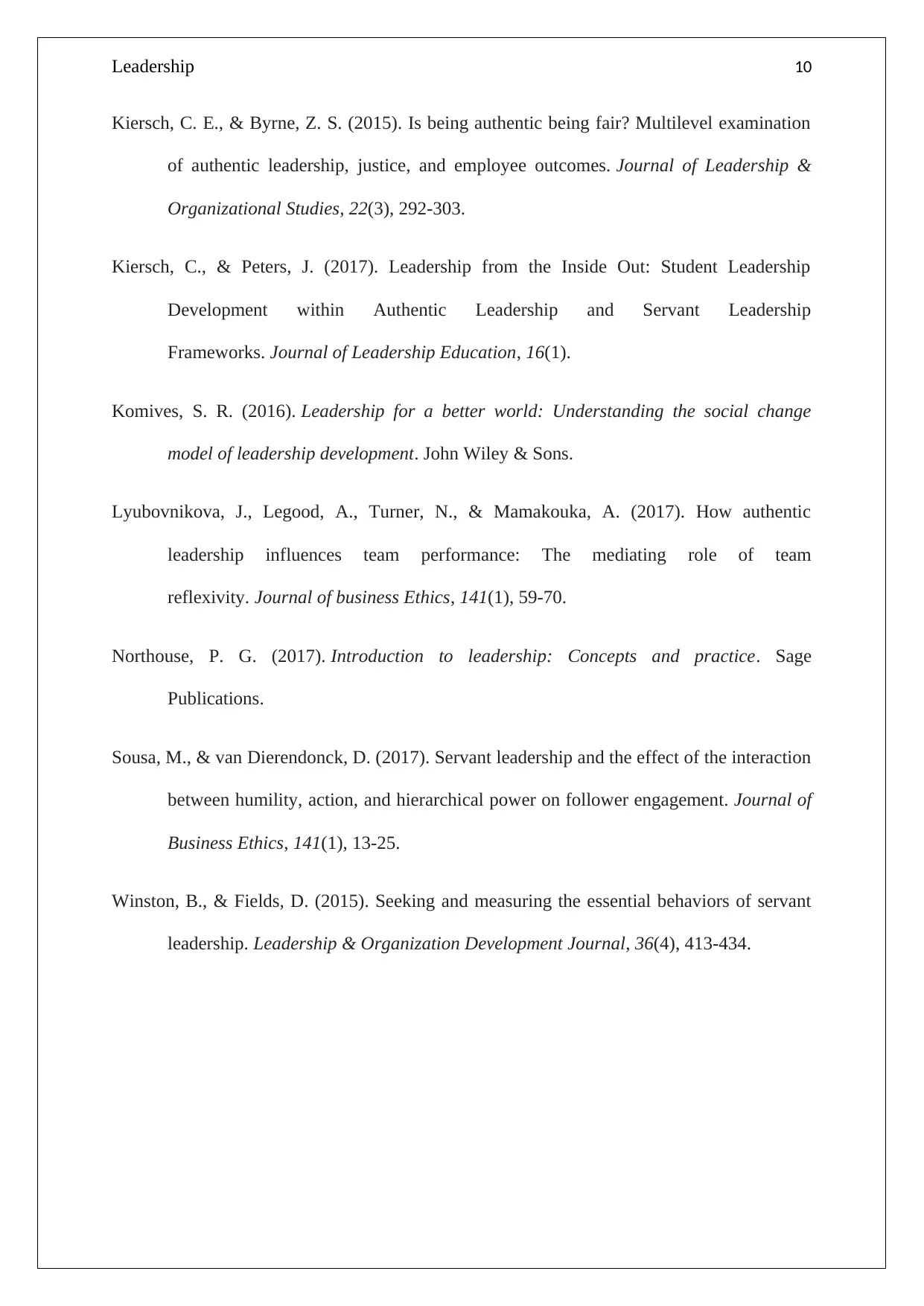
Leadership 10
Kiersch, C. E., & Byrne, Z. S. (2015). Is being authentic being fair? Multilevel examination
of authentic leadership, justice, and employee outcomes. Journal of Leadership &
Organizational Studies, 22(3), 292-303.
Kiersch, C., & Peters, J. (2017). Leadership from the Inside Out: Student Leadership
Development within Authentic Leadership and Servant Leadership
Frameworks. Journal of Leadership Education, 16(1).
Komives, S. R. (2016). Leadership for a better world: Understanding the social change
model of leadership development. John Wiley & Sons.
Lyubovnikova, J., Legood, A., Turner, N., & Mamakouka, A. (2017). How authentic
leadership influences team performance: The mediating role of team
reflexivity. Journal of business Ethics, 141(1), 59-70.
Northouse, P. G. (2017). Introduction to leadership: Concepts and practice. Sage
Publications.
Sousa, M., & van Dierendonck, D. (2017). Servant leadership and the effect of the interaction
between humility, action, and hierarchical power on follower engagement. Journal of
Business Ethics, 141(1), 13-25.
Winston, B., & Fields, D. (2015). Seeking and measuring the essential behaviors of servant
leadership. Leadership & Organization Development Journal, 36(4), 413-434.
Kiersch, C. E., & Byrne, Z. S. (2015). Is being authentic being fair? Multilevel examination
of authentic leadership, justice, and employee outcomes. Journal of Leadership &
Organizational Studies, 22(3), 292-303.
Kiersch, C., & Peters, J. (2017). Leadership from the Inside Out: Student Leadership
Development within Authentic Leadership and Servant Leadership
Frameworks. Journal of Leadership Education, 16(1).
Komives, S. R. (2016). Leadership for a better world: Understanding the social change
model of leadership development. John Wiley & Sons.
Lyubovnikova, J., Legood, A., Turner, N., & Mamakouka, A. (2017). How authentic
leadership influences team performance: The mediating role of team
reflexivity. Journal of business Ethics, 141(1), 59-70.
Northouse, P. G. (2017). Introduction to leadership: Concepts and practice. Sage
Publications.
Sousa, M., & van Dierendonck, D. (2017). Servant leadership and the effect of the interaction
between humility, action, and hierarchical power on follower engagement. Journal of
Business Ethics, 141(1), 13-25.
Winston, B., & Fields, D. (2015). Seeking and measuring the essential behaviors of servant
leadership. Leadership & Organization Development Journal, 36(4), 413-434.
1 out of 11
Related Documents
Your All-in-One AI-Powered Toolkit for Academic Success.
+13062052269
info@desklib.com
Available 24*7 on WhatsApp / Email
![[object Object]](/_next/static/media/star-bottom.7253800d.svg)
Unlock your academic potential
© 2024 | Zucol Services PVT LTD | All rights reserved.





